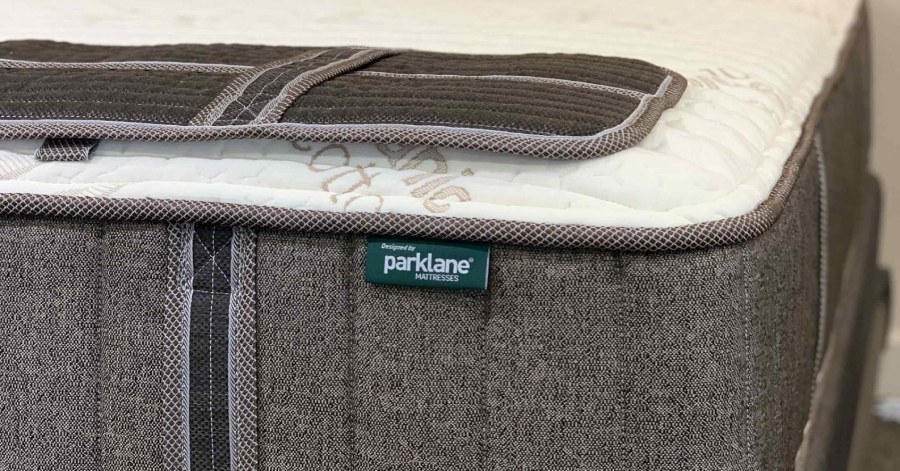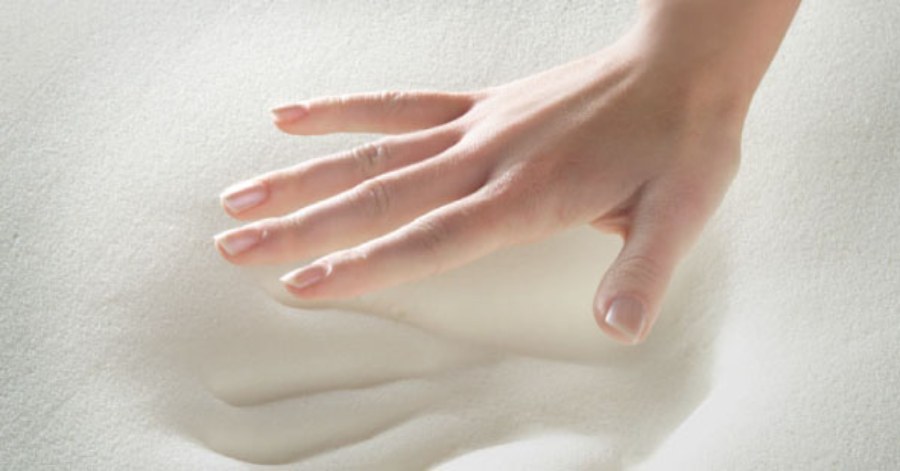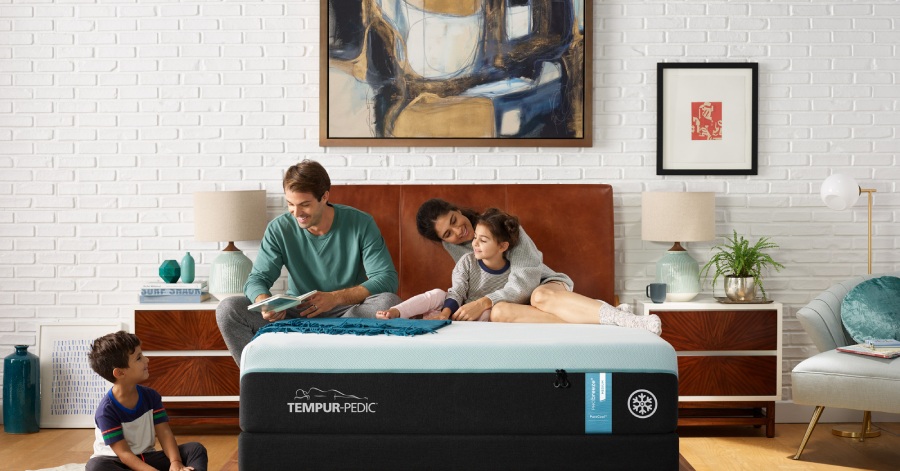Buying Guide
A good night’s rest is extremely important to living a happy and healthy life, but knowing which mattress to choose can seem like a daunting task. In this guide we will discuss the differences between the two most popular mattress styles: Innerspring vs. Memory Foam. Which is best for you?
What is an Innerspring Mattress?
An innerspring mattress is simply a mattress with a metal coil support system (and layers of foam and fabric on top of the coils). These beds often feel bouncy, yet firm and supportive, and have helped many people sleep well over the last century.

Types of Innerspring Mattresses
Innerspring mattresses have been in production since the late 1800’s, but the design and function of the coils have changed over the years.
There are a few different styles of innerspring mattresses to consider:
Bonnell Coils
- The original mattress coil design, Bonnell coils are shaped like an hourglass, where the thinner portion in the middle flexes in response to minimal pressure, and the thicker parts at the top and the bottom are designed to support greater pressure.
- This style is the bounciest, least supportive, and least expensive, and best used for children or guest room mattresses.
Offset Coils
- This design is similar to the Bonnell coil system, except with a square top and bottom, these coils flex like a hinge when compressed and provide stronger pushback under greater pressure.
- These are better suited for adults as they transfer less motion between sleepers and contour to the body better at higher weight loads.
Continuous Coils
- This coil design is made from a single piece of wire woven into multiple coils, forming rows that are connected by helical wires.
- This design is very durable, but less contouring. It is best used with a larger amount of foam on top so the sleeper will get durable support down below, with enough cushion on top to provide pressure relief.
Pocketed Coils
- The most updated version of an innerspring mattress, a pocketed coil design has each metal coil wrapped individually in a fabric pocket. Having each coil respond individually means this design provides targeted support regardless of the sleeper’s body composition, as well as reducing the motion transfer from two sleepers.
- This is the best choice for couples, or anyone looking for superior spinal alignment and support from their innerspring mattress.

Innerspring Mattress Pros and Cons
Now that we have covered what an innerspring mattress is, and the various designs and their uses, let us review the Pros and Cons of sleeping on an innerspring mattress.
Pros of Innerspring Mattresses
Enhanced breathability and cooler sleep
- Since a coil mattress has a lot of air space in the coil support unit, this encourages breathability and air flow under the sleeper, helping to prevent overheating through the night.
Bouncier feel for ease of movement
- While an innerspring mattress can sometimes feel bouncy, the push back from the coils does make moving in the mattress easier than a mattress with no coils. If mobility is a concern, an innerspring mattress may be the best option for you.
Diverse firmness levels to suit preferences
- The coils in an innerspring mattress can be made of different gauges and sizes to affect how the mattress feels overall. For example, a low gauge coil may be used to provide a firmer feel, whereas a high gauge coil may be used to allow more coils to fit in the mattress providing move targeted support and better spinal alignment.
Strong edge support for durability
- Innerspring mattresses often have strong wires about the perimeter of the mattress. This makes the sides stronger than a non-innerspring mattress and can be helpful in making sure the sleeper does not feel like they are going to roll out of the mattress.
Cost-effective with various price points
- Non innerspring mattresses typically have one low price option and one very high price option, whereas innerspring mattresses usually have options in all price points from the lowest end to the highest.
Cons of Innerspring Mattresses
Potential for motion disturbance
- While some innerspring designs have done their best to address motion disturbance (pocketed coil for example), there will always be some bounce to any innerspring mattress. If you are a very light sleeper, you may want to avoid an innerspring mattress.
Can be noisy with spring wear
- Since there is metal in every innerspring bed there is a risk of a coil breaking or wearing overtime and creating some noise. Often a squeaking or a clicking sound can become bothersome to the sleeper. There is not a way to repair inside a mattress and not all warranties cover noisy coils from wear and tear.
Minimal body contouring ability
- While the pocketed coil is the best design for contouring, in general innerspring mattresses do not conform as precisely as memory foam mattress. Depending on your support needs, an innerspring mattress may not provide enough comfortability for you.
May sag or lose support over time
- In the warranty of an innerspring mattress, your mattress can sag sometimes up to 2’’ (without laying on) before the manufacturer deems it defective. Memory foam mattresses typically have a less than 1’’ tolerance in their warranties. If avoiding body impressions is important to you, you may want to avoid an innerspring mattress.
Quality varies significantly across brands
- Quality can vary across brands, and obtaining specific information about the coil systems in each mattress is not always easy or straightforward. And since this category has the most options to choose from, making an informed decision can be a daunting task.
What is a Memory Foam Mattress?
A memory foam mattress is a mattress that is entirely made of memory foam. Memory foam, also known as viscoelastic foam, was invented by NASA and was designed to provide comfort for astronauts while dealing with intense pressure during take off.
It helps with pressure relief, weight distribution, and can help sleepers wake up without feeling stiff or sore by conforming to individuals’ bodies.

Types of Memory Foam Mattresses
Memory foam technology was developed in 1966, and memory foam mattresses have been popular since the 1990’s, over the years new technology and innovations have allowed for more options to be considered
Traditional Memory Foam
- This is the original and classic memory foam. It was the first memory foam for consumer use. Traditional memory foam is engineered to contour to your body. One problem with traditional memory foam is that it tends to retain heat.
Gel-Infused Memory Foam
- Gel memory foam incorporates gel into its construction, these gels are usually added by putting gel microbeads into the foam. These microbeads create pockets like what exists in open-cell mattresses. These gels are typically “phase-changing” materials, meaning they actively absorb and release heat from your body.
Open-cell Memory Foam
- Open-cell memory foam is constructed the same as traditional memory foam but has a different internal structure. Open-cell mattresses have internal pockets or “open-cells” that allow for air flow and ventilation throughout the mattress which helps dissipate heat.
Plant-based Memory Foam
- Plant-based memory foam uses a portion of plant-based ingredients, typically being soy, in the construction of the mattress. Plant-based memory foam tends to have a faster response time than traditional memory foam, and can help you sleep cooler.

Memory Foam Mattress Pros and Cons
Now that we’ve underlined the differences in memory foam types, we can go over some of the potential pro’s and con’s to them.
Pros of Memory Foam Mattresses
Conforming Properties
- Since memory foam was developed to contour to your body, it will mold precisely to body curves and weight distribution.
Motion Transfer
- Memory foam conforming to your body means it minimizes partner disturbance from movement as it eliminates motion transfer.
Pressure Relief
- Memory foam mattresses offer relief to pressure points by molding to the body and distributing your body weight evenly throughout the mattress.
Spine and Joint Support
- Memory foam mattresses help maintain proper spinal alightment by preventing tossing and turning throughout the night which can lead to backpain and stiffness in the morning. By conforming to your body it reduces unwanted pressure on your back and spine.
Hypoallergenic
- Memory foam is hypoallergenic so it’s great for people who are worried about allergies. It also means that it prevents the buildup of dust, model and dust mites.
Cons of Memory Foam Mattresses
Heat Retention
- Memory foam mattresses have been known to retain heat as the density of the foam can be attributed to that. But with newer models like open-cell and gel foams, sleepers are experiencing this less and less.
Less Responsive Surface
- Due to the fact memory foam contours and conforms to your body, some sleepers can have a challenging time moving on and off the mattress.
Weight of Memory Foam
- Memory foam models can sometimes weigh more than traditional innerspring models making them heavy and cumbersome to reposition and move.
Unpacking Odor
- Memory foam requires time too off-gas when unpacked, if not aired out properly it can create an unpleasant odor.
Memory Foam Feel
- Some sleepers may dislike the feeling of the mattress conforming to their body as it can have a “sinking” feeling or be overly soft.
Innerspring vs Memory Foam Mattress: What’s the Difference?
In the world of mattresses, the choice between innerspring and memory foam boils down to their core materials and how they support your body during sleep. Let’s dive into their key differences.
| Feature | Spring Mattress | Memory Foam Mattress |
| Material | Metal, Foam, Fabric | Memory Foam / Gel Foam |
| Support Core | Steel | High Density Memory Foam |
| Pressure Relief | Medium | High |
| Motion Isolation | Low to Medium High | Medium to High |
| Firmness Levels | Extra Soft to Extra Firm | Soft to Firm |
| Edge Support | Dual Coils or Foam Encasement | High Density Foam |
| Temperature Regulation | Low to Medium High | Low to Extra High |
| Durability/Lifespan | Average 10 Years | Average 15 Years |
| Price Range ex. Queen | $500 – $5,600 | $500 – $5,600 |
| Recommended For | All Ages | All Ages |
How to Choose a Foam or Spring Mattress
When choosing between a memory foam or innerspring mattress, understanding your preferences and needs is key.
Here are some tips to help guide your decision:
Assess your preferred sleeping position
- Assess your preferred sleeping position: Determine if you are primarily a side, back, or stomach sleeper to find a mattress that provides adequate support and pressure relief for your sleeping position.
Consider your body weight and type
- Consider your body weight and type: Heavier individuals may benefit from mattresses with a higher support level, while lighter individuals might prefer softer options for comfort.
Evaluate firmness needs
- Evaluate firmness needs: Choose a mattress comfort level that aligns with your body’s pressure relief needs. For example: Side sleepers need more pressure relieving materials to aid in circulation and spinal alignment.
Check for motion isolation if sharing the bed
- Check for motion isolation if you share the bed: Opt for mattresses with limited motion transference to minimize disturbances if you share your bed with a sleeping partner.
Examine temperature regulation features
- Examine temperature regulation features: Look for mattresses with breathable materials and cooling technologies to ensure a comfortable sleep temperature.
Test the edge support
- Test the edge support: Assess how well the mattress maintains its shape and support around the edges to provide a good sitting edge for getting in and out of bed and a barrier to keep from feeling like you are rolling off during sleep.
Look into the mattress’s durability and warranty
- Look into the mattress’s durability and warranty: Consider the mattress’s expected lifespan and warranty coverage to ensure long-term satisfaction with your investment.
Factor in any health concerns or orthopedic needs
- Factor in any health concerns or orthopedic needs: Choose a mattress that addresses specific health concerns or provides orthopedic support if needed. Consider if you have an indoor allergy. A mattress that is hypoallergenic like a memory foam mattress would be beneficial.
Decide on your budget
- Decide on your budget: Determine your budget range and prioritize features accordingly to find the best value within your price range. A good way to stretch your budget is to ask about financing options. Most mattress retailers have a 0% interest financing option.
Read customer reviews and ratings
- Read customer reviews and ratings: Research customer experiences to gauge overall satisfaction and potential issues with the mattress you’re considering. Most mattresses have a new model every year with minimal changes. Try researching last year’s model to gauge how customers felt about the product.
Shop at BedMart for expert advice
- Shop at BedMart for expert advice: Visit BedMart for personalized guidance and recommendations from our mattress experts to ensure you make an informed decision. Feel free to chat in, call, or send us an email for help!
Innerspring vs Memory Foam: Which is Best for You?
When deciding between innerspring and memory foam mattresses, understanding their features and benefits as they relate to you and the way you sleep can help you make the best choice.
Here’s a breakdown:
Innerspring Beds Are Better For:
- Those who prefer sleeping “on top” of the mattress
- Sleepers who tend to need edge support
- Individuals seeking a mattress with bounce
Memory Foam Beds Are Better For:
- People needing pressure point relief
- Couples needing motion isolation
- Sleepers who desire a contouring feel
Find Your Mattress at BedMart
Looking for the perfect mattress tailored to you and the way you sleep? Look no further than BedMart!
With our wide range of innerspring and memory foam mattresses, we cater to all preferences and sleeping styles.
To help find your perfect fit, check out our SmartMatch Quiz or visit BedMart in-store today for personalized assistance from our mattress experts, ensuring you find the ideal mattress for a good night’s sleep.
Your dream mattress awaits at BedMart. Visit us now!
Find Your Perfect Mattress at BedMart
Innerspring vs Memory Foam FAQs
How Long Do Spring Mattresses Last?
Innerspring mattresses are a tried-and-true mattress technology. But how long they last is dependent on how they are manufactured. BedMart has many innerspring mattresses that range anywhere from 5-15 years.
How Long Do Memory Foam Mattresses Last?
Memory Foam is the newest of the mattress materials developed in the 1960’s. Since then, memory foam has taken many forms and has had many improvements. Just like innersprings, memory foam’s longevity is dependent on how it is manufactured, lasting anywhere from 5-30 years. Being hypoallergenic, this technology could be used well past its warranty date.
Is Spring or Foam Mattress Better for Back Pain?
Many chiropractic organizations endorse both memory foam and innerspring mattresses for back pain. Both technologies have their benefits, and the decision ultimately relies on the importance of finding what works best for you, your body, and the way you sleep. Our SmartMatch diagnostic test, available online and in-store, utilizes advanced technology and over 16 million sleep profiles to gather your unique physical data to recommend the best mattresses for your sleep needs.